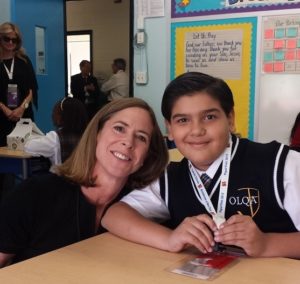 Over the summer, a group of Catholic schools in Harlem and the Bronx posted some attention-grabbing results.
Over the summer, a group of Catholic schools in Harlem and the Bronx posted some attention-grabbing results.
Their students took the same tests as children in New York’s charter and traditional public schools. State data showed that, on average, all types of schools improved. But the Partnership Schools improved faster.
For the second-straight year, the results of this experiment in urban Catholic education lent credence to the idea that— like a few related efforts elsewhere in the country — it belongs in the larger effort to improve urban school systems, particularly for disadvantaged students.
“We really can be a proof point,” Jill Kafka, the executive director of the Partnership for Inner-City Education, says in the latest edition of our podcast.
“I think what we’re able to prove and show is that Catholic schools can be an excellent choice for parents in these neighborhoods,” she says. In addition to traditional and charter public schools, “we end up being the third leg of the stool. We can bring the excellence to the point where we are part of the education reform conversation.”
The six schools are looking to turn the tide in a city beset by enrollment declines and Catholic school closures that hurt surrounding communities.
They’re also experimenting with a new management structure. An agreement with the Archdiocese of New York gives the schools operational autonomy. But they’re banded together in a network that pools resources and helps take tasks from curriculum selection to building maintenance off principals’ plates, allowing them to focus on instruction.
“We are all operating with one vision, one mission,” Kafka says. “There’s a lot of advantages in our structure that are allowing us to make change and to bring excellence, rather quickly, to the schools.”
This venture is part of the broader Catholic-school renaissance, which if it succeeds, could help strengthen the school choice movement.
Right now, the Partnership schools serve predominantly low-income students. Many of them attend with the help of privately funded scholarships. Tax credit or voucher programs could help that money go further, but those programs face political hurdles in states like New York, and, at least so far, they have a mixed record when it comes to lifting student achievement at scale.
That’s why proof points matter. Measurable improvements won’t just help sell school choice to policymakers, funders or the public. They can help show other faith-based schools what’s possible at institutions that are committed to raising academic outcomes.
Kafka says Catholic schools can be well-suited to turnaround efforts.

Their teachers don’t bear the battle scars of two decades of education reform. And the recent transformation did not mean the Partnership schools replaced teachers en masse. Instead, they provided teachers with new support — in choosing curriculum, getting feedback on their instruction, and using meaningful data on student learning throughout the school year.
The Catholic tradition of subsidiarity means individual schools make many of their own decisions, so even in a network, change doesn’t need to be dictated from a central office.
Kafka says the network has attracted some diverse supporters, from urban education reformers who also back charter schools, to donors with more faith-based motivations, whose hearts are set on revitalizing American Catholic education.


